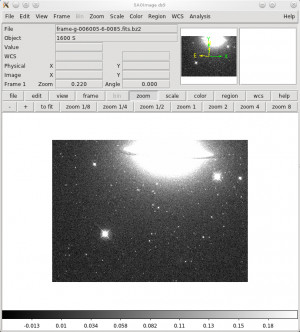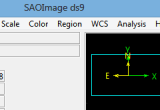
The user may generate 3-D images in Postscript, JPEG, TIFF, and other formats, just as in the 2-D case. The new module also supports FITS event files binned into a data cube.Īll printing support has been extended to the new 3-D module. The user can crop the data cube for all 3 axes via the command line or the GUI. When the user wishes to match or lock a 2-D image and to a 3-D data cube, the current slice is used to determine the rendering solution.
#Download saoimage ds9 windows
The new module is support on all hardware platforms currently supported by DS9, including 32-bit and 64-bit versions of Linux and MacOSX, and 32-bit versions of Windows and Solaris.Īll 2-D graphics, regions, cross hairs, contours, and coordinate grids, are applied to the current slice, which is selected by the user. For every doubling in the number of CPU cores available, rendering times decrease approximately 75%. For larger work stations, this number can be increase. Since all modern hardware contain multiple CPU cores, the default value is 8 threads. The number of threads actually generated is a user specified parameter. The rendering engine is developed using the POSIX thread library, allowing multiple light weight processes to be spawned to complete an image in parallel. The new module requires no special hardware or graphical processor unit (GPU) and the rendering time is adequate for interactive GUI manipulation on most computers. Instead, the time it takes to render is based on how many rays are needed to project the data cube upon the screen in the view volume and the current zoom factor. Rendering time is independent of the actual data cube size. At this point, normal DS9 operations are applied, such as scaling, clipping and applying a color map. MIP returns the maximum value encountered, AIP returns an average of all values encountered. To determine the value returned, there are 2 methods available, Maximum Intensity Projection (MIP) and Average Intensity Projection (AIP). For each pixel on the screen, a ray is projected back into the view volume, based on the current viewing parameters, returning a data value if the ray intersects the FITS data cube. The new module implements a simple ray-trace algorithm. 7.0, a new module, encompassed by the new Frame 3D option, allows users to load and view data cubes in multiple dimensions. Previous versions of SAOImage DS9 would allow users to load 3-D data into traditional 2-D frames, and would allow users to step through successive z-dimension pixel slices of the data cube. New to SAOImage DS9: 3-D Data Visualization
#Download saoimage ds9 download
More information about this package (including download links) is available at our website.


We are pleased to announce the availability of the new public release of SAOImage DS9 7.0. Bill is the primary writer and maintainer of the SAOImage DS9 tool. This is a guest post by William (Bill) Joye at the Smithsonian Astrophysical Observatory.


 0 kommentar(er)
0 kommentar(er)
